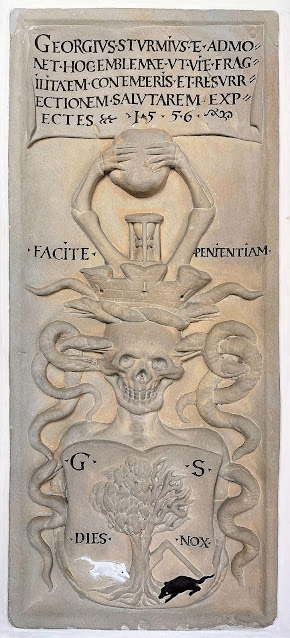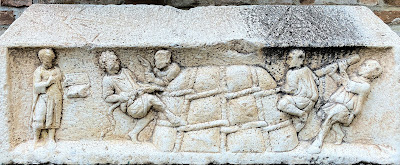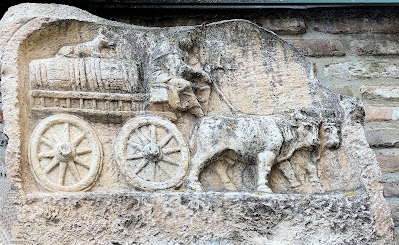Today this Roman settlement is called Augsburg, boasting a rich
historical heritage.
Following my trips to Erfurt and Regensburg, I visited Augsburg for its importance during the Reformation.

|
| Augustus, the man who started it all on a fountain at Augsburg's Rathausplatz |
*You surely remember: And it came to pass in those days, that there went out a decree from Caesar Augustus, that all the world should be taxed.
Later an Ottonian cathedral that was rebuilt in Gothic style stood at the site
of the Roman settlement.
Near the cathedral, excavations show the layout of the church St. John (on the plan in pink), built in 960 during the reign of Bishop Ulrich.
Roman findings are exposed outdoors, showing farmers and merchants.
Augsburg's Gothic cathedral is somewhat disfigured by the many attached buildings.
The Gothic high choir from the inside.
In front of the cathedral, statues of Augsburg's patron saints in late antiquity, and the early Middle Ages decorate a fountain.
Afra of Augsburg (right, † 304), allegedly the first Bavarian martyr, burned to death near Augsburg because of her Christian faith,
Bishop Simpert (left, c. 750-807), a nephew of Charlemagne, who in 778 made him bishop of Augsburg. Simpert consolidated and strengthened the jurisdiction of his bishopric, and
Bishop Ulrich of Augsburg (890-973), fighting the Hungarian invasion on horseback, was the first saint officially canonized by the Church.
Near the cathedral, excavations show the layout of the church St. John (on the plan in pink), built in 960 during the reign of Bishop Ulrich.
Roman findings are exposed outdoors, showing farmers and merchants.
Augsburg's Gothic cathedral is somewhat disfigured by the many attached buildings.
The Gothic high choir from the inside.
In front of the cathedral, statues of Augsburg's patron saints in late antiquity, and the early Middle Ages decorate a fountain.
Afra of Augsburg (right, † 304), allegedly the first Bavarian martyr, burned to death near Augsburg because of her Christian faith,
Bishop Simpert (left, c. 750-807), a nephew of Charlemagne, who in 778 made him bishop of Augsburg. Simpert consolidated and strengthened the jurisdiction of his bishopric, and
Bishop Ulrich of Augsburg (890-973), fighting the Hungarian invasion on horseback, was the first saint officially canonized by the Church.
In 1275 the Carmelites founded their monastery in Augsburg, and in 1321 the brothers began building the Annakirche. Note the coat of arms of the Fuggers, the lily.
Walking up to the entrance, I noticed a commemorative plaque. It was the first time I saw names of soldiers fallen or missed in action* during the Napoleon wars.
*Forever lost in the immensity of Russia
You enter the church, passing the impressive Goldschmiedekapelle (chapel of the goldsmiths) and ...
... admire inside St. Anna church the Fugger chapel with an unorthodox presentation of Jesus's deposition from the cross. Luther's rose proves that St. Anna is a Lutheran church.
The cloisters of St Anna with all those tombs are called the stone chronicle
of the Imperial City of Augsburg.

|
|
A Fugger buried in 1519, two years after Luther had published his 95 Theses in distant Wittenberg. |

|
| Resurrection. Christ explodes out of his tomb. |

|
|
Repent day and night |

|
| Mephisto states in Goethe's Faust: "The church has a big stomach." |
Indeed the inscription reads:
Der Herr hat befohlen Zue geben Goldt und Silber Zue seinem Heiligthumb,
solches anZunemen von Jedermann der es williglich gibt. Davon Zubesßern waß
Baufällig am Hausße des Herrn ist. Daß soll mir angenehmb sein, und will
meine Ehre erZeigen spricht der Herr
(The LORD has commanded to give gold and silver to his sanctuary and to accept
it from anyone who willingly gives it. To improve what is dilapidated in the
house of the Lord. This shall be pleasant to me and will show my honor says
the Lord GOD.)
For the thirteenth Sunday after Trinitatis, the open page of the bible showed the story of Cain and Abel, presenting the wrathful and punitive God of the Old Testament.
 |
| Augusta around 1500. Note the nave of the cathedral on the left, the Perlach Tower slightly out of axis, and the water tower on the right. |
1518 Luther's Interrogation
Martin Luther used the Carmelite monastery as a hostel and base for two weeks when he was interrogated by the papal legate Cardinal Thomas de Vio of Gaeta (Cajetan) at the Reichstag in 1518.
He left behind a melancholy text: Then God bless you, dear Augsburg and all pious citizens within. We had many a cheerful courage while in your city. Now we shall see you no more, Emperor Maximilian, 1518.
On the fringes of the Imperial Diet, Cajetan and Luther exchanged religious arguments at the Fugger town palace from October 13 to 15, 1518.
Their discussions were no longer about indulgences but about the freedom of faith for men/women that Brother Martin had experienced in his Wittenberg tower. There he recognized that the Christian God is not a God of "justice" but a merciful God and that the content of the Gospel is not the law but grace.
For Luther, a church that limits the freedom of the Almighty God's decision through social works and penitential exercises is a church without God.
So, he hurled his three sola scripture, sola gratia, sola fide, because salvation lies only in the Scriptures, in the grace of God, and in faith in Him. The cardinal - the Roman axiom extra ecclesiam non est salus* firmly in the back of his mind - exclaimed, horrified: "This means building a new Church" that would lose the monopoly of a mediator between God and the individual human being.
*Outside the Church, there is no salvation
1530 The Confessio Augustana
Today's look at the prince-bishop's residence with the medieval Pfalzturm, where the Reichstag of 1530 took place.

|
| The east portal of the palace in its present form. |

|
| Brück reading the Confessio in German in front of Charles V. |
1555 The Augsburg Peace

|
| The nave of Augsburg's cathedral |
The obligation of peace concerned the estates, which, according to the principle Ubi unus dominus, ibi una sit religio*, could impose on their subjects one religion to which the exercising publicum religionis then applied.
*Where there is a Lord, there is one religion. It was not until the 17th century that the catchy formulation: Cuius regio, eius religio was heard (He who has the power decides upon the religion of his subjects)
Followers of the other denomination were only granted the exercitium privatum religionis*. Besides, these people had the beneficium emigrandi, the right to emigrate in cases of moral dilemmas, which meant selling their belongings.
*Domestic devotion or in prayer houses without bells in contrast to public service in churches with bells
1615 High Hopes

|
| The impressive Augsburg city hall |
In 1615 the city council decided to build what is now called Der Goldene Saal. The Golden Hall, located on the second floor, forms the core of Augsburg's city hall. Finished in 1520, the Golden Hall covers an area of 552 m² and has a ceiling height of 14 meters.
The Thirty Years' War changed it all. Following the Westphalian Peace Treaty in 1648, the Reichstag met for the first time after the war at Regensburg in 1663. When the deliberations between the emperor and estates dragged on, they became permanent, Andrew so the Reichstag. Regensburg was in, Augsburg was out.

|
At the front face of the city hall, former standards for measuring length are on display. Aren't we lucky that in 1871 united Germany adopted the "French" meter?
And just around the corner, a climate camp where some radical Greens spelled out their maximum demands.
*




















No comments:
Post a Comment